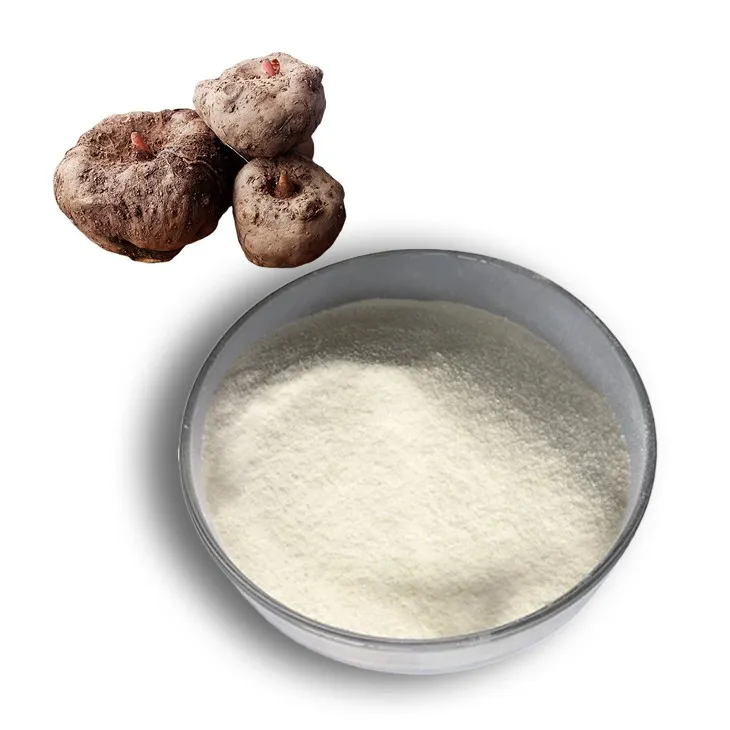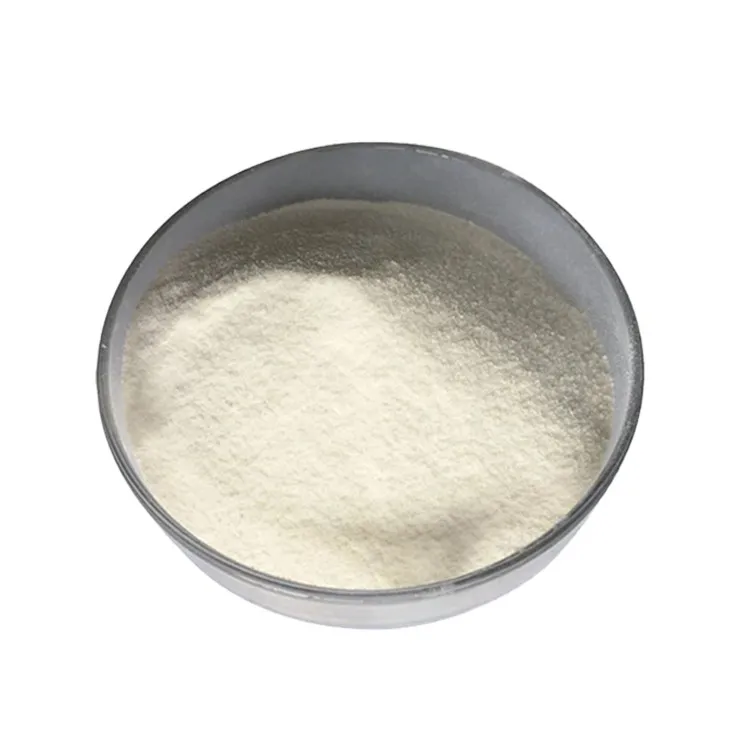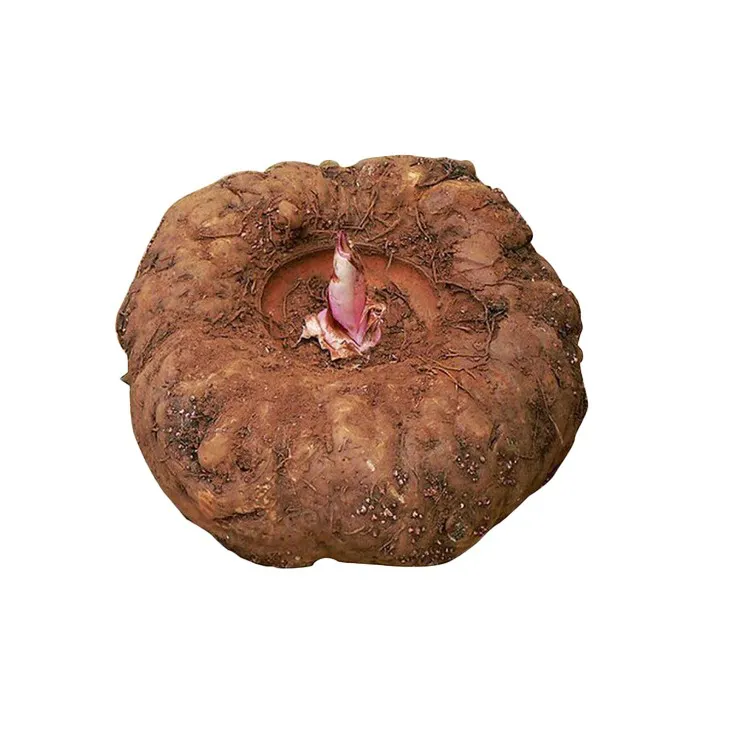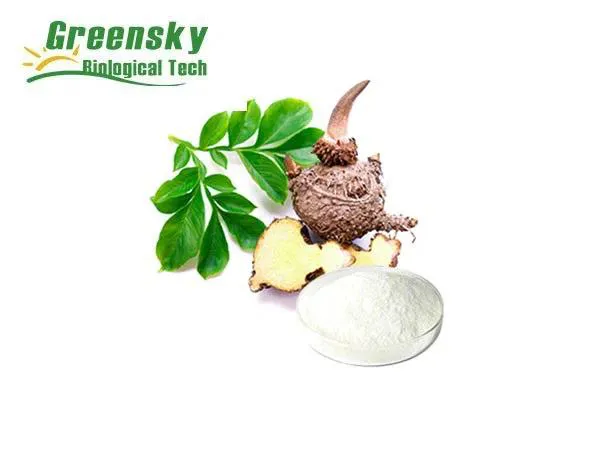- 0086-571-85302990
- sales@greenskybio.com
How to extract konjac powder from plants?
2024-11-29

1. Introduction to Konjac and Konjac Powder
Konjac is a plant with unique properties. It is native to certain regions and has been used for various purposes for a long time. Konjac Powder, which is extracted from the konjac plant, has gained significant popularity in recent years due to its numerous applications in different industries.

2. Harvesting the Konjac Plants
Harvesting at the Right Time The first step in extracting Konjac Powder is to harvest the konjac plants at the appropriate time. Konjac plants usually take a certain period to reach maturity. This period can vary depending on factors such as the variety of the plant, the climate, and the soil conditions. Generally, konjac plants are ready for harvest when the underground parts have reached a certain size and the plant has completed its growth cycle.
Careful Digging Once it is time to harvest, the underground parts of the konjac plants, which are the main source for konjac powder extraction, are dug out with care. This is crucial as any damage to the plant material can affect the quality of the final konjac powder. Special tools may be used to ensure that the entire underground tuber or corm is removed intact.

3. Initial Preparation of the Plant Material
Cleaning the Harvested Material After harvesting, the konjac plant material needs to be cleaned thoroughly. Any soil, debris, or other foreign matter adhering to the plant should be removed. This can be done by gently washing the plant parts with water.
Soaking in Water The cleaned konjac plant material is then soaked in water. This step serves multiple purposes. Firstly, it helps to soften the plant material, which makes it easier to process in the subsequent steps. Secondly, soaking can also help to leach out some of the impurities present in the plant. The soaking time can range from a few hours to a couple of days, depending on the size and nature of the plant material.

4. Mechanical Grinding
The Grinding Process After soaking, the konjac plant material is subjected to mechanical grinding. This is a crucial step in the extraction process. Special grinding equipment is used to break down the plant material into a fine consistency. During the grinding process, water is added in an appropriate proportion. This forms a slurry, which is a semi - liquid mixture containing the ground konjac plant material suspended in water.
Importance of Water Proportion The proportion of water added during grinding is very important. If too little water is added, the grinding may not be thorough, and large particles may remain. On the other hand, if too much water is added, the resulting slurry may be too dilute, which can cause problems in the subsequent filtration step. The optimal water proportion is usually determined based on experience and the characteristics of the konjac plant material being processed.

5. Sieving the Slurry
The Sieving Procedure Once the slurry is formed, it is sieved to remove large particles. Sieves with different mesh sizes can be used depending on the desired fineness of the konjac powder. This step helps to improve the purity of the slurry by separating out any unground or large pieces of plant material.
Multiple Sieving for Higher Purity In some cases, multiple sieving may be carried out to achieve higher purity. For example, a coarser sieve may be used first to remove the largest particles, followed by a finer sieve to further refine the slurry. This ensures that the final konjac powder will be of a high quality with a consistent particle size.

6. Treatment with Enzymes or Chemicals (Optional)
Enzyme Treatment In some cases, the filtrate obtained after sieving may be treated with specific enzymes. Enzymes can be used to break down certain components in the filtrate, which can further improve the purity of the konjac powder. For example, enzymes may be used to hydrolyze some of the complex polysaccharides present in the filtrate, converting them into simpler forms that are easier to separate during the subsequent evaporation step.
Chemical Treatment Chemical treatment is also an option in some cases. However, this needs to be carried out with great caution as the use of chemicals can have potential safety and environmental implications. Chemicals may be used to precipitate certain impurities or to adjust the pH of the filtrate to optimize the extraction process. But strict regulatory compliance is required when using chemicals in konjac powder extraction.
7. Evaporation to Obtain Konjac Powder
The Evaporation Process After the slurry has been sieved and optionally treated with enzymes or chemicals, the liquid part of the filtrate is evaporated. This can be done using various evaporation techniques, such as heat - based evaporation or vacuum evaporation. As the liquid evaporates, the solid konjac powder is left behind.
Controlling the Evaporation Conditions It is important to control the evaporation conditions carefully. Temperature, pressure, and the rate of evaporation all play a role in determining the quality of the final konjac powder. If the temperature is too high during evaporation, it may cause the konjac powder to degrade or lose some of its desirable properties. On the other hand, if the evaporation is too slow, it may lead to the growth of microorganisms in the filtrate, which can also affect the quality of the powder.
8. Quality Control and Packaging
Quality Testing Once the konjac powder has been obtained, it undergoes quality control testing. Various parameters are tested, such as the purity of the powder, its moisture content, and its viscosity. These tests ensure that the konjac powder meets the required standards for its intended applications. For example, in the food industry, the konjac powder must meet strict safety and quality regulations.
Packaging for Preservation After passing the quality control tests, the konjac powder is packaged. Appropriate packaging materials are used to protect the powder from moisture, air, and other environmental factors that could affect its quality. Packaging also plays a role in ensuring the long - term stability of the konjac powder and facilitating its storage and transportation.
9. Conclusion
Extracting konjac powder from plants is a multi - step process that requires careful attention to detail at each stage. From harvesting the konjac plants to the final packaging of the powder, every step is crucial in obtaining high - quality konjac powder. With the increasing demand for konjac powder in various fields, continuous research and improvement in the extraction process are also necessary to ensure its sustainable production and wide - ranging applications.
FAQ:
What are the main parts of the konjac plant used for extracting konjac powder?
The underground parts of the konjac plant are mainly used for extracting konjac powder.
Why is it necessary to soak the konjac plant materials in water?
Soaking the konjac plant materials in water is necessary to soften them, which makes the subsequent mechanical grinding process easier.
What is the role of adding water during mechanical grinding?
Adding water in an appropriate proportion during mechanical grinding helps to form a slurry, which is conducive to the subsequent sieving process.
Why is sieving carried out after grinding?
Sieving is carried out after grinding to remove large particles, which can improve the purity of the konjac powder.
Are enzymes or chemicals always used in the extraction process?
No, enzymes or chemicals are only used in some cases to improve the purity of the filtrate during the extraction process.
Related literature
- The Extraction and Properties of Konjac Flour: A Comprehensive Review"
- "Konjac Powder Extraction: Traditional and Modern Techniques"
- "Optimizing Konjac Flour Extraction from Konjac Plants"
- ▶ Hesperidin
- ▶ citrus bioflavonoids
- ▶ plant extract
- ▶ lycopene
- ▶ Diosmin
- ▶ Grape seed extract
- ▶ Sea buckthorn Juice Powder
- ▶ Beetroot powder
- ▶ Hops Extract
- ▶ Artichoke Extract
- ▶ Reishi mushroom extract
- ▶ Astaxanthin
- ▶ Green Tea Extract
- ▶ Curcumin Extract
- ▶ Horse Chestnut Extract
- ▶ Other Problems
- ▶ Boswellia Serrata Extract
- ▶ Resveratrol Extract
- ▶ Marigold Extract
- ▶ Grape Leaf Extract
- ▶ blog3
- ▶ blog4
-
The best aged garlic extract on the market.
2024-11-29
-
How to make powder with L - arginine.
2024-11-29
-
Certified organic hawthorn extract.
2024-11-29
-
Bulk purchase of mulberry leaf extract.
2024-11-29
-
Wholesale Suppliers of Eyebright Extract.
2024-11-29
-
Certified organic jujube extract.
2024-11-29
-
Nettle Root Extract
2024-11-29
-
Mangosteen extract powder
2024-11-29
-
Resveratrol extract
2024-11-29
-
Tinospora cordifolia extract
2024-11-29
-
Lavender Extract
2024-11-29
-
Rosemary extract
2024-11-29
-
Motherwort Extract
2024-11-29
-
Andrographis Paniculata Extract Powder
2024-11-29
-
Fenugreek Extract Powder
2024-11-29
-
Beta Carotene
2024-11-29





















